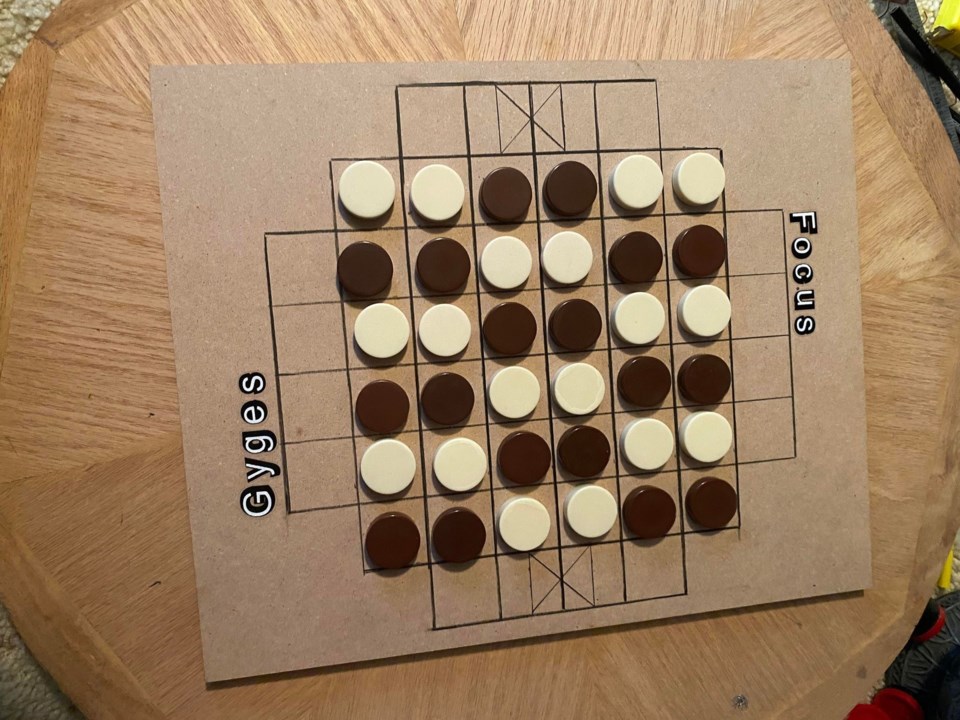YORKTON - After reviewing Peak from designer Andreas Kuhnekath it led to thoughts of other stacking games.
While there are literally dozens of games where stacking is the key mechanic, if not the ultimate goal, it became apparent that with two or three matching checker sets, always a low cost option, or a couple of matching backgammon sets, you can be well on your way to a handful of wonderful stacking games.
For the purpose of this article the goal was to keep the cost to play as low as possible, so it will be limited to games which can be played on a square grid – think a checkerboard. However, a checkerboard is an 8X8 grid, and some games need alternate-sized boards, but a ruler, pencil and some Bristol board, and it’s pretty easy to draw up a grid board of any size required.
So, to start you can look back at Peak. While the game is commercially available in a beautiful wooden edition from Clemens Gerhards, which any game player would be satisfied with, Peak can also be easily played with checkers, each player needing 18 which are initially distributed over the 6X6 board.
Laskers is a sort of checkers/Bashni-inspired creation from Emanuel Lasker. The game, created in 1911, is played on a 7X7 board and is all about jumping pieces as in checkers, but with pieces stacking and unstacking in the process. Personally this is one of the most fun checker variants to explore.
Staying on the 7X7 board we have LOT, where two players compete to be first to create a line of three stacks.
Players add pieces to the board to get three-in-a-row, then collect those pieces, leaving a stack of two in one of the spots. The first player to have three stacks in-a-row wins.
This is another game I highly recommend.
On a slightly smaller board – 5X5 – there are a trio of great stacking options.
To start there is Six Making, which admittedly is not a very exciting name, but it is a fine game.
From designer József Dorsonczky, Six Making is a game in which players challenge each other in building chess figures – one high is a pawn, two a rook, five a queen etc. You win by building a stack of six, or more (a king) with your colour piece on top.
Mixtour from designer Dieter Stein plays on the same 5X5 board.
Starting with an empty board, players add pieces and move them trying to build up stacks with five or more pieces to win the game. Once on the board either player can move any piece.
There are many move options: stacks can be split at any level but a move must always end on another stack. In fact, it is the height of the receiver stack that determines the range of possible moves, which is a very mind-bending mechanic which really makes this one a must try.
Also from Stein is his 2005 release Abande, a game often played on a hexagonal board, but can be played on a 7X7 as well. It’s a place and move stack creation game with a neat aspect that at the end you only score stacks connected to one of your opponent’s stack. Definitely a game that is worth some exploration if you create a ‘play set’ of boards and pieces.
Gordon Hamilton’s gem Santorini plays on a 5X5 board too. For this one you will need something to represent each players two men – loonies or toonies for the others perhaps.
You build towers – use one colour – and try to get one of your ‘men’ to the third level first. Players can cap towers with a fourth piece blocking its use too – use the alternate colour pieces.
This is so simple in terms of rules, but not as easy as it might appear. It’s a gem for sure.
When you create a 6X6 board then try India, a 2003 creation by Martin Windischer which uses stacking as a way to move and capture pieces while attempting to take a piece across the board to win the game.
One more game to relish if you went this direction to create an ‘all-purpose’ play set in Focus, (often seen under the name Domination). The 1963 release from designer Sid Sackson is something of a classic of that decade and old commercial sets are available. It plays, two, three and four players. The two-player option is simple to create as it is played on an 8X8 board ignoring the corner squares.
Focus is all about stacking, trying to end up with your colour pieces dominating – being on top of all the stacks on the board. It’s an older game really worth a look.
Also from Sackson, a prolific designer credited with more than 100 games of varied types, is a much under-appreciated stacking game which is also a ‘crossing’ game where you score points by moving pieces across the board. The game is Sackson’s gem Chain Reaction. This one takes what is a 7X8 board with a score track if you get fancy. An older game worth trying for sure.
Well there you have it, 10 stacking games which you can play with a bit of crafting at home. There are of course other games too; Towers of Hamburg, UnStack, etc., but the 10 will keep you playing for some time, and are collectively some of the best tried so far.
Next week, since we have boards made and pieces in hand we’ll look at a few games where the goal is getting one of your pieces across the board to your opponent’s ‘home’ row.






